['Margarita Philosophica' had] "for a half-century, aided in a
remarkable manner the spread of knowledge" {Alexander von Humboldt}
remarkable manner the spread of knowledge" {Alexander von Humboldt}
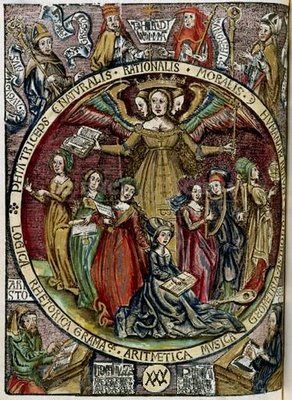
Prudentia and the 7 liberal arts (and including depictions of Saints
Jerome, Gregory, Augustine and Ambrose as well as Aristotle and Seneca).
Jerome, Gregory, Augustine and Ambrose as well as Aristotle and Seneca).
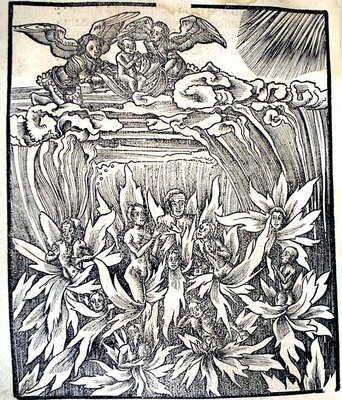
Souls in limbo.
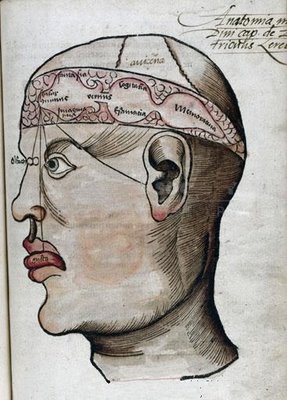
"During the middle ages it was widely thought that the various mental
faculties were each located in three ventricles in the brain. The first
ventricle was where information from the sense organs was received and
initially processed before being passed to the middle ventricle, the seat of
reason, for cogitation. Eventually thoughts were transferred to the third
ventricle which was the seat of memory."
faculties were each located in three ventricles in the brain. The first
ventricle was where information from the sense organs was received and
initially processed before being passed to the middle ventricle, the seat of
reason, for cogitation. Eventually thoughts were transferred to the third
ventricle which was the seat of memory."
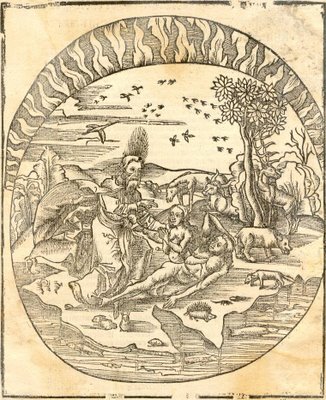
God creating Adam and Eve in the Garden of Eden.
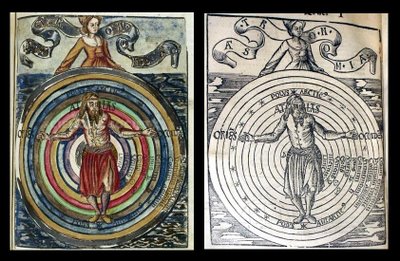
Astronomia - depiction of Ptolemy's geocentric planetary system.

Typus Musices
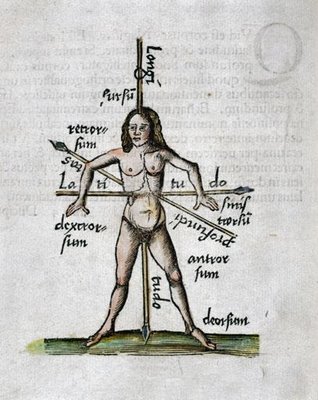
Figure representing longitude and latitude.
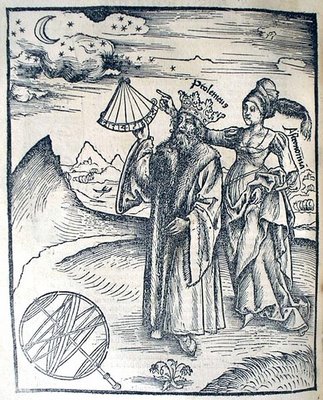
A crowned Ptolemy with the goddess Astronomia.
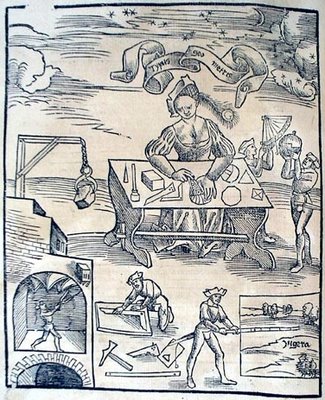
Typus Geometris

Magister and pupil.
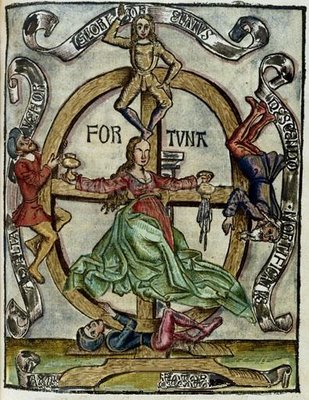
The Wheel of Fortuna.
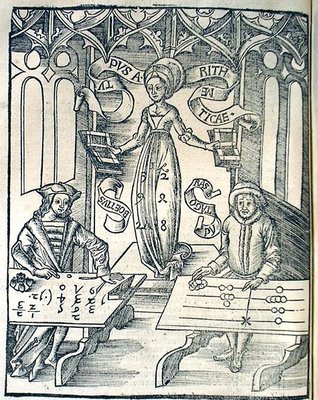
Typus Mathematicæ - a supervised competition between Pythagoras
using a type of abacus and Boethieus using the new arabic numerals.
using a type of abacus and Boethieus using the new arabic numerals.

The Branches of Knowledge, featuring Aristotle, Emperor
Justinian and Seneca. There is a sword and flowering branch
coming out of the mouth of the central female figure.
Justinian and Seneca. There is a sword and flowering branch
coming out of the mouth of the central female figure.
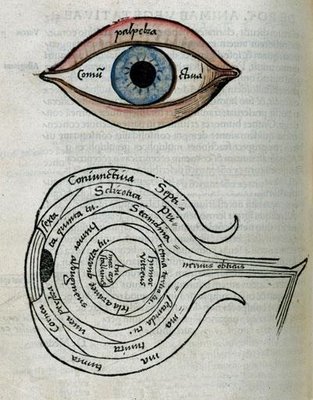
One of the earliest (if not first) schematic illustrations of the eye ever published.
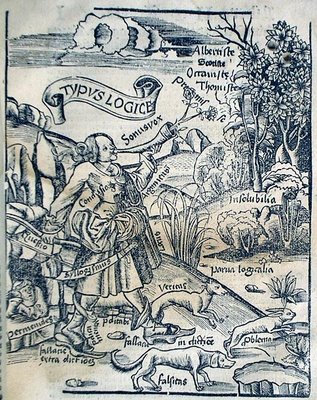
Typus Logice. An allegorical hare, representing a 'Pblenia' (problem)
is chased by two dogs, 'Veritas' (truth), and 'Falsitas' (falsity)
is chased by two dogs, 'Veritas' (truth), and 'Falsitas' (falsity)
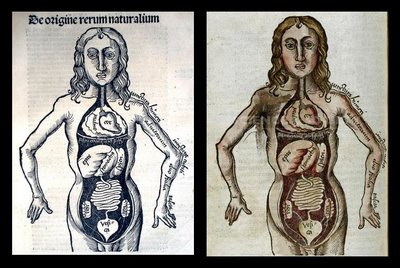
This abdominal and thoracic anatomy diagram doesn't
seem too unsophisticated, considering it is nearly half a
century before the landmark work of Vesalius.
seem too unsophisticated, considering it is nearly half a
century before the landmark work of Vesalius.
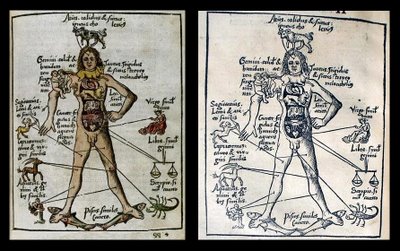
Zodiac Man indicates which body parts were associated
with each astrological sign. Inclusion of this illustration seems
a little contradictory in that Reisch was said to be skeptical of astrology,
favouring scripture and reason as a basis for understanding.
with each astrological sign. Inclusion of this illustration seems
a little contradictory in that Reisch was said to be skeptical of astrology,
favouring scripture and reason as a basis for understanding.
Gregor (Gregorius) Reisch (~1467-1525) became a Carthusian monk after matriculating as a Magister from his home town University of Freiburg in southern Germany. He would become Confessor to Emperor Maximilian I, teacher of John Eck and Martin Waldseemüller, friend to Erasmus, Beatus and Rheananus and Prior at the Carthusian Monastery in Freiburg.
His enduring legacy however, was an encyclopedic compendium of contemporary knowledge aimed at educating university students and young people called 'Margarita Philosophica' (roughly translates as 'Pearls of Wisdom'). The book was written in latin between 1489 and 1495 but was not actually published for the first time until 1503. The learned yet brief teaching manual was "widely used as a university textbook in the early sixteenth century, particularly in Germany."
'Margarita Philosophica' was divided into 12 chapters: grammar, logic and rhetoric (the 'trivium'); music, arithmetic, geometry and astronomy (the 'quadrivium') together with natural philosophy, the origin of natural objects, powers of animal sensation and intellect and moral philosophy.
The text style is in the form of a dialogue with a student asking a series of questions and the teacher providing answers (for a similar approach, see the later work of Pluche). The inclusion of a large number of allegorical woodcut illustrations by unknown artists helped to make this (?the first) encyclopedia both popular and influential. Many editions were issued, including pirated copies, and there are differing versions (and qualities) of the illustrations around.
- Gregor Reisch at the Catholic Encyclopedia.
- There are a couple of complete versions of 'Margarita Philosophica' online but I don't recommend them. The University of Valencia's copy is in a java format and is merely photocopy quality.
- Most of the black and white woodcuts above come from this ebay page.
- The colour illustrations were taken from Science & Society, which has 40 images available. I took the liberty of removing their intrusive watermark and copyright notices - 500 year old woodcuts and they assert copyright over miniature low resolution jpeg images! - that's laughable. There would be links from here to their website every week if they only displayed a modicum of cooperative etiquette. I just hope the new policy of the V&A Museum has some lateral effects. [see also 'Art History and Its Publications in the Electronic Age'] But I digress..
- Perhaps the best overall review of 'Maragarita Philosophica' is given on this University College London Book of the Month page.
- Translated version of wikipedia on 'Margarita Philosophica' [original in german].
- Various other pages with snips of information and images.
- Off on a tangent: Laputan Logic on 'The Evolution of Numbers'.
- Previously: Comenius, who came a bit later, is considered the 'father of education'.
- UPDATE (Feb 2013) A complete copy of Gregor Reisch's 'Margarita Philosophica' is now available online at the Bavarian State Library. [also see the Internet Archive which hosts U Penn's copy]
- UPDATE II (May 2013) Another complete copy from 1503 is now available from the University of Heidelberg Digital Collection (this is probably the best quality and most easily accessible overall).
- UPDATE III (Oct 2013) Eight editions of 'Margarita Philosophica' are available to view online or download from Munich Digitization Center.










































7 comments :
The illustrations are absolutely lovely. Thanks for sharing.
(Visiting via boingboing but I'll be bac!)
I found a great digitized version of the 1508 edition at http://libcoll.mpiwg-berlin.mpg.de/libview?url=/mpiwg/online/permanent/library/AN8D65DX/pageimg&start=101&pn=118&mode=imagepath
Thanks very much for that Max Planck Institute link, space_odyssey. That is indeed the best quality version I've seen.
According to this catalog (http://www.bn.br/portal/arquivos/pdf/Eproibido-Catalogo.pdf page 27) from an exhibit at Biblioteca Nacional (Brazil), the anatomy diagram from the 1503 edition had the genitals added. Then, in the 1515 edition, Reisch drawed the man with his clothes on to avoid that.
Thanks Marcos - sounds like familiar censorship down through history!
Here's the original Portuguese commentary from that .pdf :
"A comparação das duas edições (1503 e 1515) evidencia um exemplo claro de autocensura pelo próprio editor. A raridade de imagens em obras do início do século XVI, especialmente, do corpo humano nu é justificativa razoável para rasuras eróticas. Na primeira edição
da obra Margarita philosophica (1503), a imagem que reproduz o do corpo humano da cabeça aos quadris foi ‘indiscretamente complementada’, em tinta de época. Este tipo de rasura seria recorrente, pelo menos nesta obra, e teria levado o editor, na edição de
1515, a apresentar a mesma imagem, renovada e vestida o suficiente para inviabilizar esse tipo de rasura."
[TRANS.]
Is there any "translation" or rendering in a modern language of this work? Or may be a book detailing its contents? Thank you for the wonderful images. In the address http://www.digital-collections.de/index.html?c=autoren_index&l=en&ab=Reisch%2C+Gregor there are eight different digitized versions that can be downloaded as pdf files.
Thanks for that Op131. In fact, those 8 editions of 'Margarita Philosophica' can be viewed online as well, if you don't want to d/load the pdf versions.
I surmise that, because this book is of supreme importance as an historical document, there will be modern versions available, if not quilting designs, dance recitals, wallpapers and rap reinterpretations, to take things to their (un)natural limits.
That information is really outside of my purview, you might start with googlebooks & googleresearch & narrow down time frames and add suitable adjunctive search words, like: 'modern' 'translation' 'updated' etc etc. I would bet a great deal of someone else's money that there will be LOTS of different flavours of 'Margarita Philosophica' around.
Post a Comment
Comments are all moderated so don't waste your time spamming: they will never show up.
If you include ANY links that aren't pertinent to the blog post or discussion they will be deleted and a rash will break out in your underwear.
Also: please play the ball and not the person.
Note: only a member of this blog may post a comment.